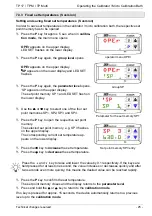
Cooling Down of the Metal Block / Liquid Bath
© SIKA • Ba_TP17-TPM-Multi_en.doc • 01/2014
8
Cooling Down of the Metal Block / Liquid Bath
CAUTION! Risk of burns:
Prior to transport or contact with the metal block / liquid bath ensure that it has cooled
down sufficiently; otherwise there is a risk of severe burns at the metal block / liquid bath
and the test specimen.
In order to cool down the metal block / liquid bath quickly, set the set temperature to a
low temperature, e.g. room temperature.
The installed fan gently and automatically switches to a higher speed for heating instruments,
thus providing more cooling air. The LED OUT 2 indicates the status of the output for the fan
control. If the LED OUT 2 lights up, the fan is running at high speed. If the LED OUT 2 does
not light up, the fan is running at low speed.
The controller switches the active cooling on for heating / cooling instruments. The LED OUT
2 indicates the status of the output for the active cooling. If the LED OUT 2 lights up, the ac-
tive cooling is running. If the LED OUT 2 does not light up, the cooling is not active.
PLEASE NOTE:
After switching off or after removing the mains connection, the installed fan can no longer
provide cooling air. Nevertheless, sufficient thermal isolation between the metal block /
liquid bath and the housing is still guaranteed.
9
Cleaning and Maintenance
Allow the calibrator / micro calibration bath to cool down as described in sect. (
Switch the calibrator / micro calibration bath off and disconnect the mains plug.
9.1 Maintenance
The TP 17 / TP M / TP Multi is maintenance-free and cannot be repaired by the user. In case
of a defect, the device must be replaced or returned to the manufacturer for repair.
CAUTION! Material damage!
When opening the device, critical parts or components can be damaged.
Never open the device and perform any repair yourself.
9.2 Cleaning
External cleaning:
Clean the TP 17 / TP M / TP Multi with a dry or slightly damp lint-free cloth. Do not use sharp
objects or aggressive agents for cleaning.
Cleaning the fan grille:
Each calibrator is fitted with a small meshed air grille via which cooling air enters the calibra-
tor.
Clean the grille at regular intervals (vacuuming or brushing) depending on the level of air
pollution.













































